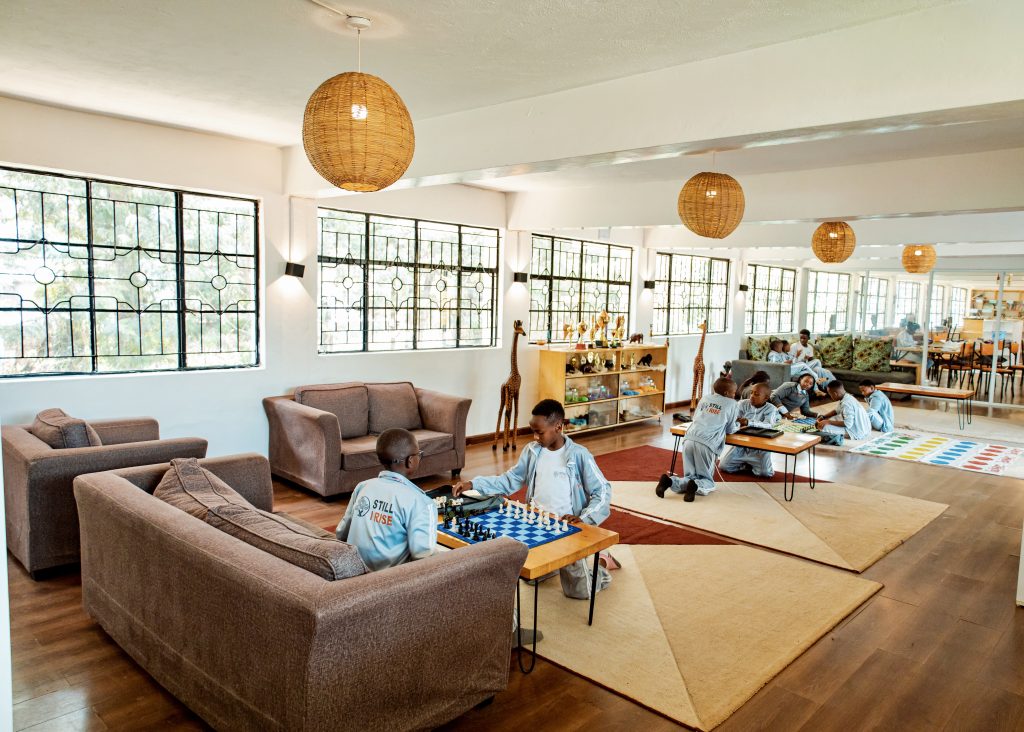
School is Home
KEY WORD: BEAUTYA cozy home where beauty, happiness and zest for life thrive.
Overview
Students spend much of their young lives at school, which should therefore be set up with the love and care it deserves, as a second home for them, a place where children go through a valuable phase of life beyond just learning in school. Basically, our schools should be a place students are excited to be in, wishing they could stay there longer. One of the reasons our students don’t want to leave School is that they are surrounded by beauty, which tends to be a severely neglected notion in school settings. Yet research shows that the more beautiful a school is, the more likely one is to feel good in it and have a better predisposition to learning and succeeding.

The Common Hall
The Common Hall is the beating heart of our School space and encapsulates the idea of School is Home.
Located at the entrance to each of our Schools, it sets the tone for the rest of the space. In an area that in most schools is often designed only for staff and visiting adults, it is important to us instead that first and foremost students feel welcomed. This is where the school day begins when they arrive, where they spend recess, and where they relax during breaks and while waiting for buses to take them home.
Students use the common room to read, share stories, do research, play board games, draw, chat, and talk with a teacher about a project. Cozily furnished and softly lit, with comfortable sofas and houseplants, it has the look of a beautiful living room.
By relaxing in a comfortable and beautiful environment that says “welcome to your home,” children open up to each other and to teachers, creating important bonds.

Mutual Care
A house takes care of its people, and people take care of the house.
We take care of our students by providing them with the space and opportunities to grow not only mentally and academically, but also physically and emotionally. There are outdoor spaces and facilities in our Schools where students can exercise regularly and receive nutritious meals every day as well as packages of essential goods for their families. In addition, all students have access to individualized psychosocial services when needed, and we work with them on developing social-emotional skills.
We also encourage them not to see themselves as mere beneficiaries, but as active agents of change who can take care of others and their School, which is Home, and where everyone has tasks to perform.
In fact, every afternoon, students take turns repairing, cleaning, tidying and decorating the School. There is no difference between boys or girls, younger or older; everyone takes responsibility. It is important for our future leaders to learn the value of things and of living in a pleasant space, as well as to recognize the work done by the cooks and cleaners around them.

School of Happiness
Happiness is important-it is central to our humanity. That’s why we create an environment that helps bring happiness and measure its effectiveness. 91 percent of our students say that school actively helps to bring happiness into their lives: it is a home where they can feel safe, comfortable and stimulated.
The reasons for this high level of happiness are countless. One of them is that we give our students the opportunity to explore and discover, breaking out of the bubble each grew up in before joining us. Students read one or two books a month to open their minds to other worlds and participate in events and field trips. When they return home they work on projects that consolidate those new experiences, and at School they are in contact with people from different cultures, as we often receive guests for workshops and classes.
Another reason for happiness is the comforting feeling of togetherness generated by collaborative classroom activities, extracurricular clubs several times a week, and sharing the excitement of movie nights or Christmas parties.

School for life
School should not exist for the sake of it, but to be the home of life. A life richly lived in the present of childhood and a preparation for a full and rewarding adult life.
We consciously connect lesson objectives with the realities of the everyday world around students and potential future careers. Students truly understand why they learn what they learn in class.
School days and weeks are long to allow children to be in this safe and stimulating home. They do all their work here; in fact, we don’t give “homework” because it can be divisive-not all of our students would be able to keep up because many don’t have artificial light or the dry, quiet space they need to concentrate at home. Breaks from class provide rest, while productive campus and extracurricular activities provide a stimulating distraction.
A key presence in our school schedule is a flexible, focused daily session where students develop an independent growth mindset and engage in productive activities, from the gym to reading, researching or planning a school event.

